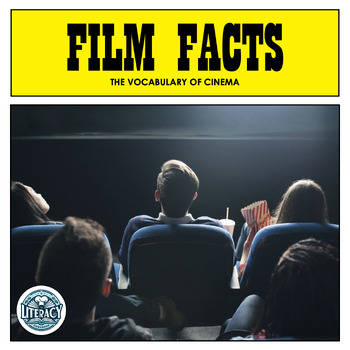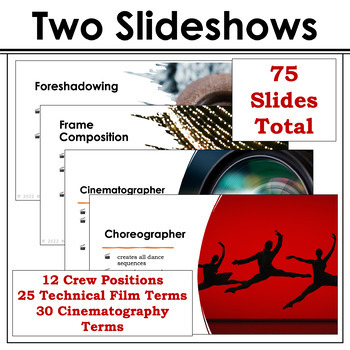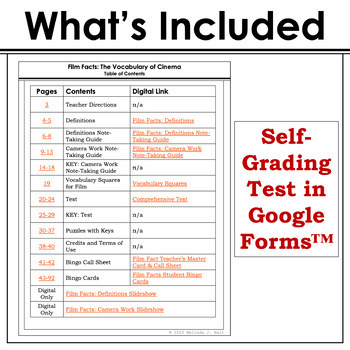Film Terminology - Cinema Vocabulary for Analyzing Movies
- PDF
- Google Apps™

What educators are saying
Description
Analyzing movies can be difficult without a working vocabulary of film techniques. This lesson gives a thorough and effective background in film for students to use cinematic vocabulary to analyze movies! The lesson is most effective in an ELA, Film Studies, or Social Studies class that integrates film analysis into the curriculum. When used early in the year, students develop a working vocabulary to analyze films at a deeper level.
This Film Facts packet provides you with the resources you need to teach your students how to use the technical jargon of movies to gain a deeper understanding of the art form and also broaden the scope of their analysis skills.
_______________________
Serving Suggestions: For an introduction to the vocabulary of film, students learn the terms and definitions so they can apply technical terms when analyzing movies in a film course, an ELA or social studies classroom, and their personal viewing.
Ingredients: (Print or Digital)
- Film Facts: Definitions (2 digital pages)
- Vocabulary Squares (Tailored to Film)
- Comprehensive Test (5 pages, self-grading: 100 points, multiple choice questions)
- Film Facts: Definitions Slideshow (41 digital slides)
- Film Facts: Definitions Note-Taking Guide (3 pages)
- Film Facts: Camera Work Slideshow (34 digital slides)
- Film Facts: Camera Work Note-Taking Guide (5 pages + Key)
- Print Bingo: pp. 40-91 of this document.
- Film Facts Student Bingo Cards (50 digital cards)
- Film Fact Teacher’s Master Card & Call Sheet (2 pages)
Procedures: (for printed copies)
- Distribute either the definitions list or the note-taking guide to students digitally or in print. Use the first slideshow (Film Facts: Definitions: Slideshow) to go over the terms with students.
- Distribute the Camera Work note-taking guide to students digitally or in print. The second slideshow on cinematography (Film Facts: Camera Work Slideshow) helps students understand the camera terms by providing visual examples.
- The Vocabulary Squares page is for students to use with the words they find confusing or challenging to understand and should be used as needed. It is helpful with cinematography.
- The crosswords and word search are an opportunity for students to interact with the terminology.
- The Bingo Game is an opportunity for students to review 24 of the terms by playing Bingo. I have provided 50 cards in the PDF and in Google Slides™️ for the review. The card numbers are in the bottom left corner edge of the page. The printed Bingo game is straightforward; however, the digital version can be a little tricky to manage. If you play more than once and students use the same cards, you should mix up the order of the call sheet by printing, cutting & separating the definitions you call from and drawing from a hat.
- After you have made a digital copy of Film Facts Student Bingo Cards, make your card file settings SHARED WITH ANYONE WITH THE LINK.
- On the first slide are links to the 50 individual cards. You can assign students card numbers and direct them to this document. Once they use the link to their individual cards, students should go to FILE --> MAKE A COPY-->SELECTED SLIDES (only theirs selected in the document) and play Bingo from the copy they made from your original.
- Each Bingo card has a draggable film reel in the center to use as a marker. Students should mark the term for the definition you call out.
- You can give prizes for those with BINGO—instead of buying prizes, you can give students a choice. I let my winners choose between two movies I had planned to show or choose the next genre unit we would study in film class. Extra credit is also a “free” option.
- Finally, there is a comprehensive self-grading test to assess whether students have learned the technical jargon. The real test is their use of the vocabulary while analyzing films for class. Asking students to look for examples (especially camera shots and angles) in their personal viewing at home is a great way for them to master the concepts. I ask my students to take screenshots and email them to me, and then I use those in class to reinforce the terminology.
____________________________
The lesson is most effective in an ELA, Film Studies, or Social Studies class that integrates film analysis. When used early in the year, students develop a working vocabulary to analyze films at a deeper level.
_____________________________
How to get TPT credit to use on future purchases:
Please go to your “My Purchases” page (you may need to login). Beside each purchase you'll see a Provide Feedback button. Simply click it and you will be taken to a page where you can give a quick rating and leave a short comment for the product.
Each time you give feedback, TPT gives you feedback credits that you use to lower the cost of your future purchases.
I value your feedback greatly as it helps me determine which products are most valuable for your classroom so I can create more for you.
Be the first to know about my new discounts, freebies and product launches:
Look for the green star next to my store logo and click it to become a follower, or CLICK HERE! You will now receive email updates about this store.
I will be adding more film resources to my store in future weeks. Follow my store to know when I post a new product!
All the best,
Melinda @TheLiteracyCookbook
theliteracycookbook@gmail.com or melindajhall@literacycookbook.net





